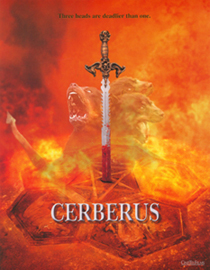Beyond the Slimy Wall: Cerberus
By Stephanie Star Smith
January 19, 2006
BoxOfficeProphets.com

Cerberus
As I mentioned in my last column, when Sci-Fi Originals pictures hits it, it's to homerun proportions. Conversely, when Sci-Fi Originals misses, they miss by a Grand Canyon-width margin.
Happily, Cerberus falls into the former category.
For those who have forgotten, or perhaps were never taught, elementary-school Greek mythology, Cerberus was a three-headed dog with the tail of a serpent that was the guardian of the gates of the Underworld, ruled by Hades. Cerberus allowed the dead to pass into the Underworld, but prevented any from escaping; he also prevented the living from having access to the world of the dead. According to myth, few outside of Hades were able to control Cerberus; only Heracles, who subdued the fierce beast and brought him to the upper world in order to complete his Twelfth Labor, and Orpheus, who lulled Cerberus to sleep with a lyre in order to enter Hades and rescue Eurydice, are credited with having any success in handling Cerberus.
In this film, Cerberus takes on another task, that of protector for Attila the Hun, or more importantly, Attila's legendary weapon, the Sword of Mars (and why a creature from Greek mythology would be involved with an artifact from Roman mythology isn't addressed, so it's best not to dwell on that for too long). According to legend, the sword of the Roman god of war was given to Attila so he would invincible in battle, and that it was buried with him when he died. Since then, Cerberus has stood guard over the sword, killing those unlucky few who stumble across its hiding place and try to remove the sword from its proper resting place, which is clasped tightly between the skeletal hands of the Scourge of God. The only clues to its location are on the breastplate worn by Attila, in the form of characters that are apparently an ancient form of Romanian. Which, naturally, makes the breastplate valuable to more than collectors of antiquities and museums; otherwise, there'd not be much of a story here.
The action pretty much starts from the opening scene, with a daring robbery of Attila's shield. From there, we learn the legend of the Scourge of God and the Sword of Mars, and then it's into the meat of the story, as an archeologist and a group of American operatives from some shadowy agency that's never identified try and track down the Sword of Mars before a mercenary procures it for a renegade North Korean general who has a slew of dirty bombs and believes in the sword's legendary powers, making him a man who, as one of the characters points out, you would not want to have feeling he was invincible. In the course of tracking the Sword of Mars, we learn more about the characters involved, and are rewarded with a number of double-crosses, spectacular explosions, gory deaths, and a giant three-headed dog with the tail of a serpent rampaging through a small Romanian village.
Can't be bad.
And it's not. In fact, Cerberus is one helluva great thrill ride. The script is tight, the actors more than capable, and the special F/X are quite good, particularly for a Sci-Fi Originals production. The big concern in a flick like this, of course, is how good - or bad - is the animation of the eponymous beastie? Well, Hidden Fortress - the F/X company that handled the work on Cerberus - isn't going to be giving ILM a run for its money any time soon, but they proved more than capable in this task. Granted, it's fairly easy to tell that you are watching a CGI creation rather than an actual creature whilst Cerberus is on-screen, but I mean, come on; it's not like the filmmakers could go down to Central Casting and page through their 8x10s of three-headed dogs with serpents for tails and find just the right one. Cerberus actually came out looking pretty good and moving somewhat authentically; the animators even paid enough attention to make sure that the heads not only moved independently of one another, but didn't look dorky doing it. No small feat. And the three heads rending humans to pieces and then feasting? Now that's some fine-looking CGI!
The acting is serviceable, and in fact some of the performances are a cut above the norm for such fare. Greg Evigan in particular seems to relish his former-good-guy-gone-horribly-bad role, and after one of the expected-but-you'd-be-disappointed-if-it-wasn't-there plot twists, edges over into scenery-chewing territory, with delightful results. A word of praise must also be given the scripters, Raul Inglis and John Terlesky; in a film where the focus is on a mythical creature or monster of some sort, there's a tendency to create one-dimensional stock stereotypes instead of three-dimensional characters that the audience can actually give a damn about whether they're eaten or not. That Inglis and Terlesky resist the temptation of the former and instead trod the latter path, creating fully-realized people instead of soon-to-be-three-headed-dog fodder stick figures is a laudable choice, and makes the movie that much more enjoyable.
Cerberus manages to draw its disparate elements together into an interesting and cohesive whole, telling a story that blends mythology with historical fact, modern-day terrorism and the ever-present wild card of human avarice, and weaves a compelling whole that is much greater than the sum of its parts.
I see by the shadows falling from my bust of Pallas that our time is up. Until next time, then, when we will once again venture Beyond the Slimy Wall.